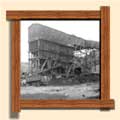 Heritage Community Foundation Presents
Heritage Community Foundation PresentsAlberta Online Encyclopedia
 |
|||
  |
|||
|
Home>> People and Communities>> Geographical Communities>> Boom and Bust Towns>> Boom Towns>> East Coulee |
|||
| East Coulee | |||
Established in 1924, by renowned entrepreneur John Nicholas Murray, the East Coulee mine was located in remote land, with no roads or railway leading to it. A steep bank just west of the mine caused even the Canadian National Railway (CNR)—who had built a line through Drumheller in 1912—to be reluctant to build a new spur line to East Coulee due to high cost. Instead, farmers and ranchers hauled coal using their horse-drawn sleighs, across the frozen Red Deer River in the winter. Another shipping method involved moving the coal upriver to Rosedale, where the CNR cars shipped the product to Calgary. It was not until 1928, when the Canadian Pacific Railway (CPR) built a line to Drumheller, that East Coulee expanded. The same year the CPR tunneled though the obstructing hill, charging the area with explosives. With all traffic halted, the CPR exploded the side of the hill and started building tracks on the newly formed inner shelf. Prior to the railway, East Coulee residents lived in relative isolation. With no viable transportation, miners had nowhere to go and found little to do during leisure hours. Ultimately, similar to many Drumheller Valley communities, businesses catering to a predominantly male population (such as brothels, bars, gambling dens, and night restaurants) opened to success. The overall appearance of the town seemed rather thrown together, as if it grew overnight and in the absence of municipal bylaws. Contributing to the sense of impermanence in East Coulee was the fact that most miners wanted to make quick money and settle elsewhere. Their work was difficult, seasonal, and dependent on current coal prices; in times of economic strain, miners needed to be ready to move on. As a result, most felt no permanent attachment to the community and the town reflected this. At its height, the town grew to 3,000 people. Additional
mines were built in the area and included the Aetna and
Bullock’s Empire Mine. Today, the Atlas mine in East Coulee
remains open as a tourist destination. Visitors may explore the
more than 120 metres of underground passageways. The historic
site caters to the curious, and stands as a testament to the
working conditions of a Drumheller Valley mine. |
|||
 |
|||
For more on coal mining in Western Canada, visit Peel’s Prairie Provinces.

